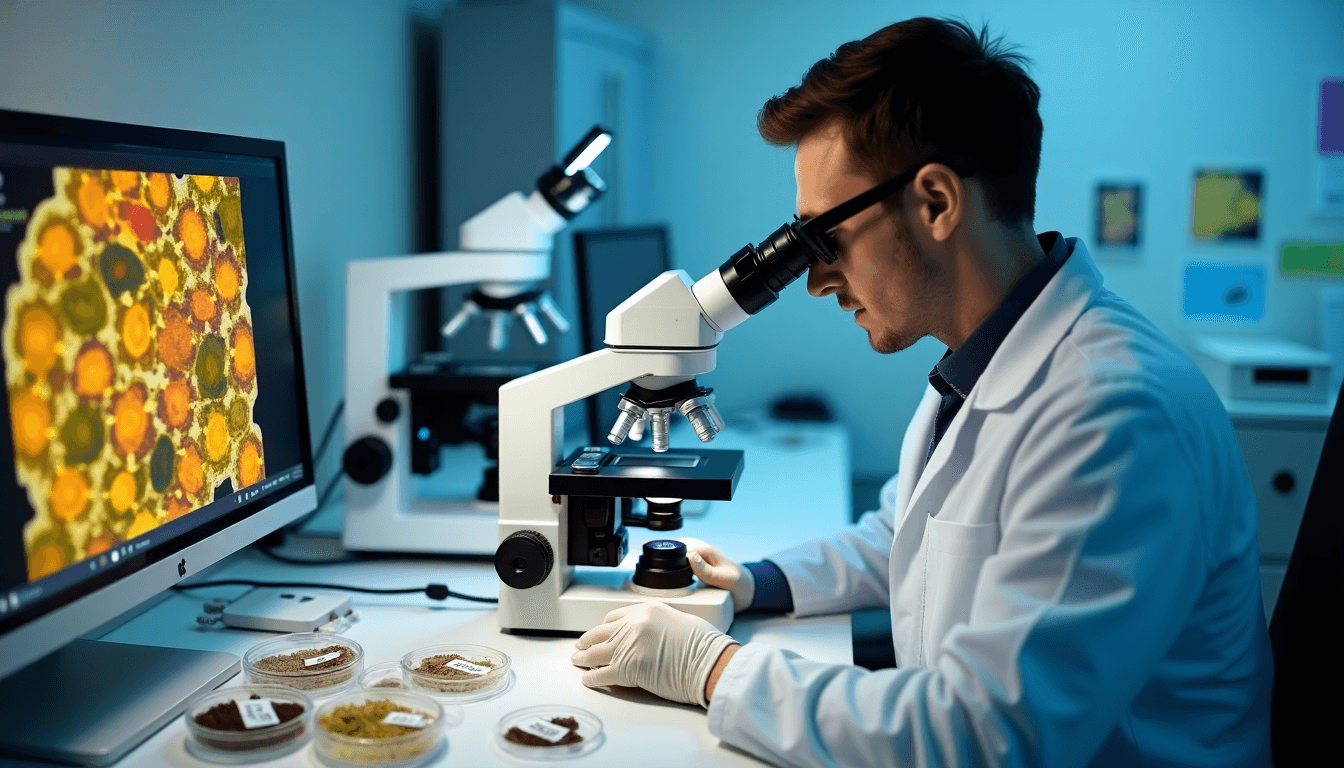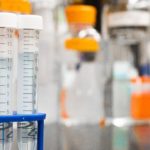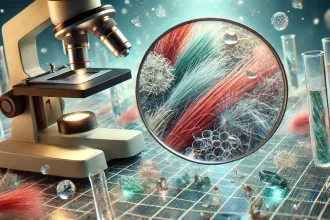Pollen grains can survive for an amazing 450 million years in the right conditions. These tiny particles serve as one of nature’s most lasting pieces of evidence
- Understanding Forensic Palynology: Science Behind the Evidence
- What is forensic palynology and its rise?
- Pollen and Spores:
- Types of pollen evidence in criminal cases
- Key principles of pollen analysis
- Forensic Significance:
- Collection and Analysis Methods
- Crime scene collection protocols
- Laboratory processing techniques
- Advanced analytical tools and technologies
- Modern Forensic Palynology Techniques
- Digital imaging and analysis systems
- DNA-based pollen identification
- Artificial intelligence applications
- From Crime Scene to Courtroom
- Landmark Criminal Cases
- The 1959 Austrian murder case
- Modern applications in homicide investigations
- Drug trafficking investigations
- Challenges and Limitations
- Conclusion
- FAQs
- How does forensic palynology contribute to solving crimes?
- What are the main techniques used in modern forensic palynology?
- What challenges does forensic palynology face in criminal investigations?
- Can you provide an example of a landmark case solved using forensic palynology?
- How is forensic palynology used in drug trafficking investigations?
- References & Further Readings
Forensic palynologyPalynology is the study of palynomorphs - microscopic structures of both animal and plant origin that are resistant to decay. This includes spermatophyte pollen, as well as spores (fungi, bryophytes, and ferns), dinoflagellates, and various Read Full Definition, which studies pollen and spores in criminal investigations, has become a powerful tool for solving crimes. Nature contains about 380,000 different types of pollen grains. Forensic palynologists must become skilled at identifying roughly 6,000 pollen types from their reference collections. This specialized science has proven valuable in solving complex cases, especially in situations like the Baby Doe case. Pollen analysis helped investigators link the victim to the Boston area.
Understanding Forensic Palynology: Science Behind the Evidence
‘Palynology’ is based on the Greek word ‘the study of powder and dust.’ Thus, palynology studies the microscopic structures of plants and animals resistant to decay. This includes various organic organisms such as spermatophyte pollen, spores, and dinoflagellates.
In legal cases, forensic palynology studies pollen and spores to link people, objects, and locations. This unique field stands out because it helps investigators connect suspects to crime scenes using microscopic evidence.
What is forensic palynology and its rise?
Forensic palynology is the application of the study of modern and fossil spores, pollen, and other acid-resistant micro-plant remains to investigate legal matters in criminal and civil cases, often used to establish links between objects, people, and places based on the analysis and identification of pollen.
Early forensic experts saw pollen as botanical dust debris, but the field has grown remarkably. Today’s forensic palynologists analyze approximately 380,000 different types of pollen grains. They use reference libraries with up to 6,000 pollen types to identify samples.
Pollen and Spores:
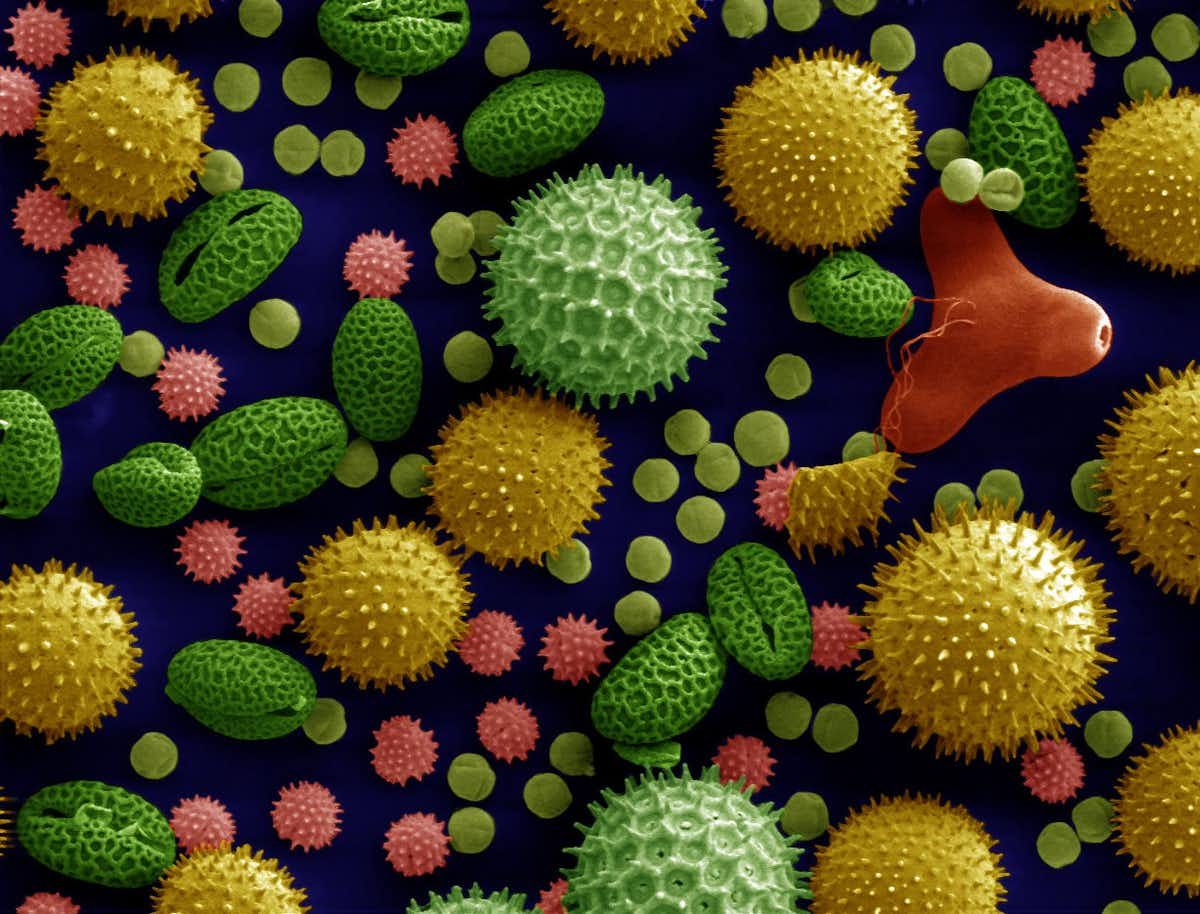
Pollen and spores are the tiny, powder-like reproductive units of plants. Pollen is utilized in sexual reproduction. In contrast, spores are for asexual reproduction. They can be obtained from an extensive range of items, thus providing clues about the source of the materials and the environment’s characteristics from which they are sourced. Pollen can be classified by size, shape, color, and features of their apertures and ornamentation.
Pollens are produced in great numbers by plants and, being tiny and light-weighted, are dispersed throughout the immediate environment in several ways. Either via wind, insect, or another method. For example, anemophilous plants produce pollen that is distributed by wind. While Zoogamous plants use rodents and bees to disperse their pollen, Autogamous plants self-pollinate and produce their own pollen.
Types of pollen evidence in criminal cases
Pollen evidence shows up in many forms in crimes of all types. Forensic investigators collect pollen samples from:
- Bodies, including nasal passages and stomach contents
- Clothing, fabrics, and footwear
- Soil samples and air filters
- Ropes, twines, and other physical evidence
- Illegal substances and contraband
Key principles of pollen analysis
Several fundamental principles make forensic palynology work. Pollen grains have complex structures that help identify their parent plant taxa. These microscopic particles, ranging from 7 to 200 micrometers, stay invisible to the naked eye. Pollen grains resist decomposition thanks to their cell walls made of cellulose and sporopollenin – some of the most chemically resistant organic molecules known.
The science depends on objective discriminant analysis examining pollen grain assemblages and their unique types within collections. Modern analysis uses several sophisticated techniques, including transmitted-light microscopy, widefield fluorescent methods, and structured illumination approaches. These tools help forensic palynologists create detailed environmental profiles and establish geographical connections with remarkable accuracyIn scientific and measurement contexts, "accuracy" refers to the degree of proximity or closeness between a measured value and the true or actual value of the measured quantity. Accuracy indicates how well a measurement reflects Read Full Definition.
Forensic Significance:
Forensic palynologists often use large-scale collections of pollen to aid in identifying certain plant species. The advantage lies in their abundance, dispersal mechanisms, mechanical and chemical destruction resistance, microscopic size, and morphology. Their abundance, tiny size (typically less than 50 um), and numerous dispersal mechanisms prevent them from inadvertently transporting them away from scenes of interest without providing any visual clue to a suspect. On the other hand, their complex morphology allows the identification of an individual parent plant taxon related to a specific ecological habitat or a specific scene, their relative frequencyFrequency is a fundamental concept in physics and wave theory. It refers to the number of times a specific point on a wave, such as a crest or trough, passes a fixed reference point in Read Full Definition, and areas of the year where they occur.
Spores and pollen are used frequently in criminal investigations like theft, rape, terrorism, bombing, arson"Arson" is a criminal act involving intentionally and unlawfully setting fire to buildings, structures, or other property types. It is a serious offense and is considered a crime in most legal jurisdictions. Here are key Read Full Definition, tracing of drugs, poaching, hit-and-run cases, etc. Following are some examples of how forensic palynology can be helpful in a criminal investigation.
- To establish the relation between the suspect and the crime scene.
- To establish the link between an item and the crime scene.
- Traces history of traveling (thus positively indicates where a person or object has been).
- Traces environmental information of the primary crime scene.
- To prove the presence of the victim and perpetrator at the crime scene.
- It helps in shortlisting the suspect window.
- Specifies whether the crime scene is primary or secondary.
- Assists in the determination of Human remains deposition duration.
Numerous high-profile cases involving forensic palynology and recent advancements in multi-disciplinary approaches to environmental analysis have earned public and law enforcement attention in the field due to the possibility of gaining more accurate and detailed information regarding the crime scene in criminal investigations.
Collection and Analysis Methods
The success of forensic palynology investigations depends on careful sample collection and analysis protocols. These procedures must be precise"Precise" refers to the degree of closeness or consistency between multiple measurements or values taken under the same conditions. It indicates how well these measurements agree with each other, regardless of whether they are accurate Read Full Definition to ensure reliable evidence in criminal cases.
Crime scene collection protocols
Forensic palynologists use specialized techniques to collect pollen samples from many sources. We collect samples mainly from mud, soil, dust, hair, packing materials, and stomach contents. The process needs spotlessly clean equipment. Fresh sets must be used at each location to avoid cross-contaminationCross-contamination - The unwanted transfer of material between two or more sources of physical evidence. For example, improperly collecting biological evidence such as blood could lead to one sample mixing with another sample and contaminating Read Full Definition.
Experts use the ‘Pinch’ method to collect soil samples. They walk in a grid pattern across a 50-100 meter square area. Each sample goes into sterile plastic bags that are sealed tightly to keep the sample pure. Transparent cellophane tape works well as a collection tool when there’s minimal dust.
Laboratory processing techniques
The lab analysis starts with careful extraction procedures that change based on the sample type and amount. Standard preparation includes several chemical treatments:
- Potassium hydroxide treatment
- Schulze solution application
- Hydrofluoric acid processing
- Heavy liquid separation using zinc bromide
These processes isolate pollen grains while keeping their unique characteristics intact. Lab analysts must balance thorough extraction carefully to prevent pollen grain damage during chemical processing.
Advanced analytical tools and technologies
Modern forensic palynology uses sophisticated analytical methods. Three main imaging techniques have emerged: transmitted-light microscopy, widefield fluorescent method, and structured illumination. These tools show detailed pollen characteristics clearly.
DNA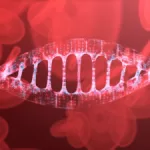 DNA, or Deoxyribonucleic Acid, is the genetic material found in cells, composed of a double helix structure. It serves as the genetic blueprint for all living organisms. Read Full Definition barcoding stands out as a major breakthrough in pollen analysis. This technique uses five genetic markers: rbcL, matK, ITS2, trnL, and psbA-trnH spacer. High-throughput DNA sequencing lets analysts study multiple pollen types at once without separating them first.
DNA, or Deoxyribonucleic Acid, is the genetic material found in cells, composed of a double helix structure. It serves as the genetic blueprint for all living organisms. Read Full Definition barcoding stands out as a major breakthrough in pollen analysis. This technique uses five genetic markers: rbcL, matK, ITS2, trnL, and psbA-trnH spacer. High-throughput DNA sequencing lets analysts study multiple pollen types at once without separating them first.
The field keeps growing with artificial intelligence applications. The GOFIND model helps identify geographic origins through plant species’ geospatial signatures. This mathematical model considers complex factors in forensic samples and opens new possibilities to determine precise locations in criminal investigations.
Modern Forensic Palynology Techniques
Technology has pushed forensic palynology into a new age of precision and efficiency. Advanced digital technologies now work alongside traditional microscopy. This combination gives us unprecedented accuracy when identifying pollen.
Digital imaging and analysis systems
Forensic pollen analysis now relies on three main imaging methods. Transmitted-light microscopy (TLM) shows the highest recall rates among all image types. The widefield fluorescent and structured illumination (Apotome) methods work together as complementary approaches. These modern techniques deliver better results faster than scanning electron microscopy (SEM).
DNA-based pollen identification
DNA barcoding stands as a breakthrough in pollen analysis. Scientists use five genetic markers in this method:
- Ribulose-bisphosphate carboxylase (rbcL)
- Maturase K (matK)
- Internal transcribed spacer 2 (ITS2)
- tRNA gene
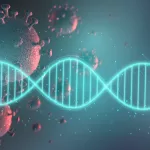 Genes are DNA segments (or RNA in some viruses) that dictate cellular processes, traits, and hereditary information, promoting genetic diversity and evolution in living organisms. Read Full Definition intron region (trnL)
Genes are DNA segments (or RNA in some viruses) that dictate cellular processes, traits, and hereditary information, promoting genetic diversity and evolution in living organisms. Read Full Definition intron region (trnL) - Chloroplast intergenic psbA-trnH spacer
DNA barcoding combined with high-throughput sequencing lets scientists analyze multiple pollen types simultaneously. Research shows that pine pollen’s DNA remains testable for up to 14 days on cotton clothing. This extends the window for evidence collection significantly.
Artificial intelligence applications
AI has become a powerful tool in forensic palynology. The PALINOVIC algorithm uses computer vision and geotechnology to achieve a 90.51% success rate in pollen grain classification tests. Deep convolutional neural networks can identify pollen with remarkable accuracy. These networks train on pollen image banks containing 35 botanical families. The systems analyze both morphological features and geographic distributions to improve forensic investigations.
Machine learning algorithms have made pollen analysis faster and more accurate. Neural networks quickly process vast amounts of pollen data Information in analog or digital form that can be transmitted or processed. Read Full Definition by mimicking brain activity patterns. These automated systems can spot patterns and anomalies that humans might miss. This sets new standards for analyzing evidence in criminal investigations.
Information in analog or digital form that can be transmitted or processed. Read Full Definition by mimicking brain activity patterns. These automated systems can spot patterns and anomalies that humans might miss. This sets new standards for analyzing evidence in criminal investigations.
From Crime Scene to Courtroom
Legal integrity in forensic palynology depends on strict evidence-handling protocols. The trip from original collection to courtroom presentation follows rigorous standards that ensure admissibility and reliable pollen evidence.
Chain of custody requirements
A chronological documentation trail tracks evidence movement from collection through analysis. Each person who handles pollen samples must sign and date all documentation and use sterile containers with unique identifiers. Laboratories must keep accurate accountability records and restrict access to properly controlled storage facilities. Sample containers need proper sealing with sterile zip-lock bags or screw-top plastic containers and complete identification tags.
Documentation and reporting standards
Forensic palynology reports must include general methods, results, and conclusions that peers can review. Another scientist must verify technical accuracy before report issuance. Case files must contain:
- Chain of custodyChain of custody - The process used to maintain and document the chronological history of the evidence. Documents record the individual who collects the evidence and each person or agency that subsequently takes custody of Read Full Definition records
- Submittal requests
- Bench notes
- Electronic data locations
- Technical review documentation
- Final detailed report
Expert testimony preparation
Expert witnesses in forensic palynology cases face unique challenges in court presentations. They must be ready for questions from both direct examination and cross-examination. Testimony preparation includes organizing materials, improving presentation skills, and developing clear demonstrations of investigation methods. Expert witnesses should focus on:
- Understanding jurisdictional requirements for expert testimony
- Mastering case-specific details and methodology
- Preparing visual aids and demonstrations
- Maintaining professional demeanor and credibility
Courts in New Zealand and the United Kingdom accept forensic palynology as an established technique. The United States faces different challenges because pollen analysis serves intelligence purposes rather than criminal prosecution. This acceptance varies between jurisdictions and requires thorough preparation and documentation to support evidence admissibility.
Landmark Criminal Cases
Forensic palynology has shown its remarkable ability to solve complex crimes throughout history. Cases from groundbreaking investigations to modern applications prove that pollen evidence provides vital investigative leads.
The 1959 Austrian murder case
Forensic palynology made its first documented appearance in criminal investigation near Vienna, Austria. A man’s disappearance along the Danube River led to murder charges against a suspect. The case lacked evidence until investigators found muddy boots that belonged to the defendant. Wilhelm Klaus, a palynologist at the University of Vienna, analyzed the mud samples. He found modern pollen from spruce, willow, and alder trees among 20-million-year-old fossil hickory pollen grains. This unique combination existed in only one small area near Vienna. The suspect led authorities to the victim’s body at the exact location the pollen analysis had indicated.
Modern applications in homicide investigations
The Baby Doe case in Boston demonstrated forensic palynology’s power in 2015. Investigators found an unidentified toddler’s remains in a trash bag on Deer Island. A detailed analysis of pollen from the victim’s clothing, blanket, and hair showed the child had been in an urban environment with specific ornamental plants, including Lebanese cedar trees. The evidence guided investigators to the Arnold Arboretum area, which led to the victim’s identification and two suspects’ arrest.
Drug trafficking investigations
U.S. Customs and Border Protection has expanded forensic palynology beyond traditional crime solving. Pollen analysis connected two major marijuana seizures in 2011:
- An 8,000-pound seizure from a San Diego warehouse
- An 8,646-pound seizure in Starr County, Texas
The analysis revealed these seizures shared a connection in cultivation or packaging despite being over a thousand miles apart. Investigators found a unique sagebrush pollen marker pointing to specific Mexico regions. This discovery helped them track drug trafficking routes and organizations. The scientific method now helps track other narcotics, such as cocaine, heroin, and crystal methamphetamine shipments.
Challenges and Limitations
Forensic palynology provides powerful investigative tools, yet the field faces fundamental challenges that limit its adoption and effectiveness. These challenges span technical, legal, and resource-related areas that need careful evaluation in forensic investigations.
Technical and methodological constraints
ContaminationContamination - The unwanted transfer of material from another source to a piece of physical evidence. The inadvertent touching of a weapon, thereby adding fingerprints to it is an example of evidence contamination. Read Full Definition is a significant challenge in forensic palynology. Crime scene integrity can be compromised when search teams cut foliage or track pollen on their shoes. Pollen samples need meticulous handling because moisture and bacterial growth can degrade evidence quality. The automated method to recover pollen requires extensive labor and a manual selection of 350-700 pollen grains.
Legal admissibility issues
Courts in different jurisdictions vary in their acceptance of pollen evidence. Forensic palynology is nowhere near as scientifically validated as nuclear DNA analysis. The Law Commission’s recommendations about admissibility tests have significant implications for forensic disciplines that rely on expert witnesses. Pollen analysis guides investigations, but courts often question pollen assemblages’ uniqueness, unlike DNA fingerprinting with its precise probabilities.
Resource and expertise shortages
The lack of qualified professionals creates a critical bottleneck. The United States had no academic centers or training facilities dedicated to forensic palynology as of 2008. The field struggles with several resource challenges:
- Limited funding, with forensic science receiving only 46.0% of available project funding
- Traditional forensic evidence types like fingerprintsFingerprint, impression made by the papillary ridges on the ends of the fingers and thumbs. Fingerprints afford an infallible means of personal identification, because the ridge arrangement on every finger of every human being is Read Full Definition and DNA receive merely 1.3% and 5.1% of total funding, respectively.
- No detailed international databases exist for pollen identification.
Resource limitations go beyond financial constraints. The field lacks trained analysts who can process palynological samples. This expertise gap becomes problematic, especially when dealing with underdeveloped regions with no pollen calendars, increasing workload and analysis time. Of course, the limited number of full-time palynologists affects case processing and creates substantial backlogs in forensic investigations.
Conclusion
Forensic palynology helps investigators turn tiny pollen grains into vital evidence that solves complex crimes. DNA analysis, digital imaging systems, and AI applications have changed this field by a lot since experts first used it in 1959.
This discipline shows its real value by knowing how to link locations through pollen signatures. Cases like the Baby Doe investigation and international drug trafficking operations proved this connection. DNA barcoding and AI-powered identification systems have boosted the accuracy and speed of pollen analysis.
Despite that, significant problems still exist. The lack of qualified professionals, money shortages, and different legal standards across courts create significant obstacles. These issues and an 18-to-24-month case backlog in the United States show why we need more resources and standard practices in forensic palynology.
This field’s success depends on solving these challenges while building on its proven track record in criminal cases. As technology improves and expertise grows, forensic palynology will, without doubt, keep providing practical insights. This helps investigators find key evidence when traditional forensic methods fail.
FAQs
How does forensic palynology contribute to solving crimes?
Forensic palynology uses pollen and spores as evidence to establish connections between people, objects, and locations in criminal cases. By analyzing the unique pollen assemblages found at crime scenes or on suspects, investigators can link suspects to specific geographical areas or prove their presence at a crime scene.
What are the main techniques used in modern forensic palynology?
Modern forensic palynology employs advanced techniques such as digital imaging systems, DNA-based pollen identification, and artificial intelligence applications. These include transmitted-light microscopy, DNA barcoding, and machine-learning algorithms for automated pollen classification and analysis.
What challenges does forensic palynology face in criminal investigations?
Forensic palynology faces several challenges, including the risk of contamination during evidence collection, varying legal admissibility across jurisdictions, and a shortage of qualified professionals. Additionally, the field struggles with limited funding and a lack of comprehensive international databases for pollen identification.
Can you provide an example of a landmark case solved using forensic palynology?
One notable case is the 1959 Austrian murder investigation, where pollen analysis of mud from a suspect’s boots led to the discovery of a victim’s body. The unique combination of modern and fossil pollen identified a specific location near Vienna, ultimately resulting in the suspect’s confession.
How is forensic palynology used in drug trafficking investigations?
In drug trafficking cases, forensic palynology helps trace the origin and transportation routes of illegal substances. By analyzing pollen found on seized drugs, investigators can identify specific regions where the drugs were cultivated or packaged, enabling them to track and disrupt trafficking networks.
References & Further Readings
- https://www.cbp.gov/frontline/frontline-june-2016-forensics
- https://liberalarts.tamu.edu/blog/2020/09/07/a-silent-witness-how-analysis-of-pollen-can-solve-crimes/
- https://nij.ojp.gov/nij-hosted-online-training-courses/law-101-legal-guide-forensic-expert/general-testifying-tips/overview-expert-testimony-preparation
- https://www.biologydiscussion.com/palynology/forensic-palynology/forensic-palynology-meaning-analysis-and-problems/64740
- https://www.researchgate.net/publication/283699052_Protocols_for_forensic_palynology
- https://www.researchgate.net/publication/316884937_Forensic_Palynology_Sample_collection_and_sample_preparation_for_forensic_investigations
- https://pmc.ncbi.nlm.nih.gov/articles/PMC7182995/
- https://news.asu.edu/20210506-pollen-crime-solving-tool
- https://rsdjournal.org/index.php/rsd/article/view/30422
- https://rsdjournal.org/index.php/rsd/article/download/30422/26553/353714
- https://nij.ojp.gov/nij-hosted-online-training-courses/law-101-legal-guide-forensic-expert/pretrial/pretrial-motions/chain-custody
- https://nij.ojp.gov/nij-hosted-online-training-courses/law-101-legal-guide-forensic-expert/sources-scientific-evidence/testing-or-evaluating-evidence-and-writing-reports/chain-custody-typical-checklist
- https://africanwildlifeforensics.org/s/annex-18-standards-and-guidelines-for-forensic-botany-identification-2.pdf
- https://blog.seakexperts.com/preparing-your-expert-witness/
- https://www.sciencedirect.com/science/article/abs/pii/S0379073806005007
- https://environment.yale.edu/news/article/the-science-of-pollen
- https://qz.com/1635897/the-us-is-using-pollen-to-track-illegal-drugs-like-fentanyl
- https://en.wikipedia.org/wiki/Forensic_palynology
- https://www.azolifesciences.com/article/The-Use-of-Forensic-Palynology-in-Solving-Crimes.aspx
- https://www.researchgate.net/publication/348362471_Identifying_the_Scene_of_a_Crime_Through_Pollen_Analysis
- https://www.sciencedirect.com/science/article/pii/S1355030613000282
- https://www.irjmets.com/uploadedfiles/paper//issue_12_december_2023/47167/final/fin_irjmets1702130454.pdf
- https://www.sciencedirect.com/science/article/pii/S2589871X19301457
- https://ymerdigital.com/uploads/YMER231005.pdf
- https://www.sciencedirect.com/science/article/pii/S1319562X20300723
- https://www.biotechniques.com/analytical-chemistry/a-silent-witness-how-analysis-of-pollen-can-solve-crimes/



